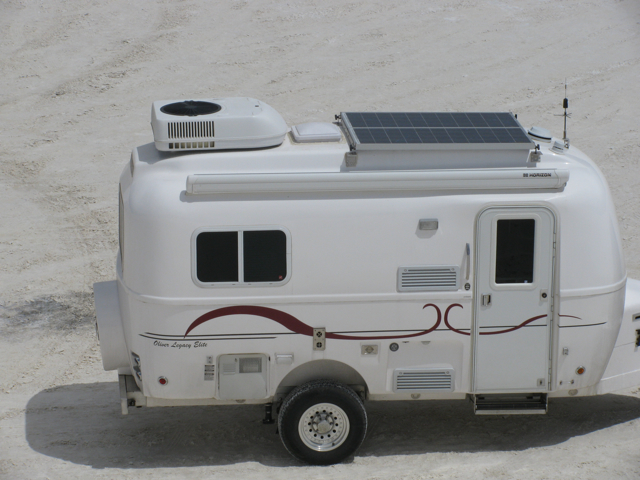
2012 Update: This post was written based off our last RV – a 17′ Oliver Travel Trailer that was designed for being off grid. After 3 years of full time travel in the Oliver, in June 2011 we moved into a 35′ vintage bus to create something more versatile. We are in the process of designing an off-grid able, high-tech, home & office on wheels that is run off entirely electric and diesel (ie. no propane). We are experimenting with Lithium Ion batteries, and our bank is sized to run our air conditioner. We’ll soon add a solar array to the roof. And we are well on our way to our Propane Free Goal. If you’d like to follow along – please use the RSS subscribe feature over there —->.
It seems like every week we get an email or two asking us for more details about our solar RV travel trailer setup, what components we use, what things we run off of solar, and how well being solar powered is working for us overall.
We get so many questions that it seems like a good idea to try and answer them all in one place. So here goes:
What are the specs?
Our solar electrical system consists of:
- 2x AM100 100-watt Solar Panels – These two panels are bolted together on the top of our roof, giving us 200 watts of sun harvesting capability. Our roof mount is technically capable of being tilted, but since we don’t have a ladder to easily reach our roof to make adjustments we have kept our panels perpetually flat – sacrificing some efficiency for a lot of convenience.
- 2x Lifeline GPL-4C 6V AGM Batteries – These two “golf cart” style batteries provide us with 220 amp hours of overall battery storage capacity. AGM-style batteries cost more, but allow for faster and more efficient charging, and they do not require any maintenance.
- Blue Sky 2512iX Solar Boost Charge Controller – A fabulous MPPT-capable charge controller. For more details why we selected this controller, read our solar charge controller options post.
- Blue Sky IPN-ProRemote Battery Monitor – A real battery battery monitor that tracks amps in/out (and not just the battery voltage) is essential to efficiently using solar power. To learn more, check out our RV battery monitoring post.
- Xantrex Freedom 458 Inverter / Charger – The inverter / charger we selected can provide up to 2000 watts of AC power from our batteries when we need it, and when we are plugged in to shore power or our generator the 100 amp charging circuit can rapidly top off our depleted batteries much quicker and more efficiently than any trickle charger.
Did you install the system yourselves?
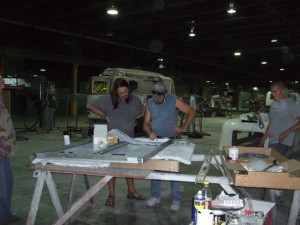 Chris did the entire solar conversion on his old 16′ Tab trailer himself, and we had been planning to do the work gutting the electrical on our next trailer to bring it up to our standards. But the great folks at Oliver Travel Trailer were willing to work with us to customize our new trailer exactly how we wanted it, so Chris researched and worked out the specifications on our solar system for our Oliver, right down to the gauge wiring.
Chris did the entire solar conversion on his old 16′ Tab trailer himself, and we had been planning to do the work gutting the electrical on our next trailer to bring it up to our standards. But the great folks at Oliver Travel Trailer were willing to work with us to customize our new trailer exactly how we wanted it, so Chris researched and worked out the specifications on our solar system for our Oliver, right down to the gauge wiring.
The Oliver crew then procured, fabricated and installed our system (we were onsite for some of the installation and assisted) as part of our custom build. They even went so far as to make some modifications to their overall trailer design to accommodate our desires for maximum solar space on the roof, such as moving the A/C and vent fan back further to make more space for the panels.
Oliver now offers the system Chris designed as a standard package, and they have sold several units with the “technomadia package” using the same components as ours.
(And no, we don’t get kickbacks…)
What would you do differently?
Overall we have been extremely happy with most of the components we selected.
If we were building the system from scratch we would once again investigate every new possibility for more solar panel wattage and battery capacity, and the one major change we would make would be going with a sine-wave inverter / charger rather than the modified-sine-wave Freedom 458.
(Our 24″ monitor makes a faint whine when plugged into modifed-sine-wave power, even when it is turned off…)
What all can you run off the solar?
We can run all of the following off our solar power:
- Lights
- Ceiling Vent Fan
- 12v small oscillating fan
- 2x Macbook Pro 15″ Laptops
- 1 Mac Mini (our trailer’s media and backup server), plus attached external drives
- Cradle Point ctr350 Router (converts our Sprint aircard to wifi)
- iPhone and camera battery chargers
- 24″ Dell Ultrasharp Monitor (via the inverter)
- Electric jacks/levels
- Water pump
- Furnace fan
- Cellphone booster system
- Small single serve smoothie blender (via the inverter)
We have optimized our systems so that nearly everything can run directly off of 12v power, allowing us to mostly avoid needing to turn on the inverter. The only things which we are unable to run directly off of 12v is our 24″ LCD monitor, and our small blender. The inverter has a bit of a power overhead just being on, so we minimize our reliance on it as much as possible.
Now.. we don’t run all these things all the time, mind you.
What don’t you run off solar?
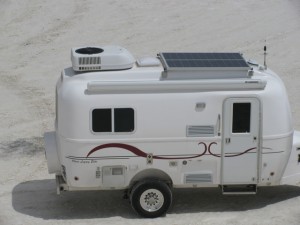
Our refrigerator can run off 12v power, but it’s incredibly inefficient in this mode and it would quickly drain our batteries even on the sunniest of solar-producing days. Propane refrigerators like ours cool by producing heat, so it is most efficient burning propane when we’re off-grid, or 110v when we are plugged in.
It is also essentially impossible to power an air conditioner off of a solar system – the demands of even a small 1000-1500W air conditioner would require a huge expanse of solar panels, and massive banks of batteries to provide for even a few hours of air conditioning per day.
When we’re off-grid and really need it, we have a small 2000 watt Honda EU2000 generator converted to run off propane that will run our air conditioner. Our furnace (aside from the fan) and hot water heater are also propane powered.
We left the microwave/toaster oven option off our unit, though technically our inverter would be large enough to power it. But even though we could, running a microwave for even 15 minutes a day would impact our battery life, and honestly, it’s not our style of cooking anyway. We greatly appreciate the extra pantry space that decision afforded us.
How have you optimized your systems to run off solar?
All our our lights are converted to LED. This is a fairly easy switch to make, and we used LED Wholesalers to find replacement bulbs for our existing fixtures. We spent about $200 to switch all our bulbs out – pricier than standard bulbs, but so worth it for the power savings. We can turn all our lights on, and combined they use less power than a single halogen bulb previously did.
We have 12v MacBook power supplies from MikeGyver and HyperMac for our MacbookPros, that allow us to run our laptops without the power overhead of the inverter needing to be on. And we use a 12v power supply from Carnetix for our Mac Mini.
How long can you depend on solar power only?
It depends.
Summer? Winter? Shade? Clouds?
We designed our system with a goal of enabling a full day of computing (8-12 hrs) for both of our Macbook Pros, plus using the lights, vent fan, and occasional water pump use.
With moderate use of our technology, we can easily go several days on end without even thinking about power much. During the summer with daily full sun, we have lasted as long as 12 days completely off grid without needing to top off with our generator – and we probably could have lasted much longer.
More typically, we tend to go 3-6 days at a time without much concern, providing we’re not in the shade or there aren’t overly overcast days.
If we are trying to make our batteries last, it is important to pay close attention to our batteries and how quickly we are draining or charging them. We ran a series of tests on every individual electrical item we own in various states of usage to know exactly how much power everything draws, so we can optimize our usage as needed
Our BlueSky battery monitor is absolutely essential here – it gives us a real time indications of our power usage, which keeps us very in tune with our system.
When we are trying to maximize our efficiency and off-grid stamina, we do need to be conservative with our power usage. We keep our power consumption to a minimum, and reward ourselves at night with a movie on the ‘big screen’ if we’ve ended the day with a good power score. Our goal is to always keep the batteries at above 50% capacity to ensure their health. Generally we can charge the batteries around 20% in a good day of moderate use and sunshine, so anytime we start creeping below 80% at night we know we are likely to soon need an alternate source of energy to top us back off.
Are you off-grid all the time?
No.
We stay in a wide variety of places – and we have our solar system to increase our options, not to depend on it completely. Our ability to run completely off solar is dependent upon the weather and access to a clear sunny sky. In the winter, with shorter days, we tend to need to be plugged in more. If we’re parked at a friend’s house in partial shade or at a shady campground, we’ll also usually need a little help power wise.
And if we encounter a string of heavy overcast days, we can’t rely strictly on solar either.
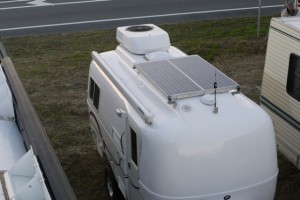 As our batteries also charge off our tow vehicle’s alternator as we drive (and yes, the solar panels continue to top off the batteries as we drive too), our transition days tend to be unplugged – as we have plenty of power to keep us computing overnight. Even if we have no sun at all, a full battery charge can keep us going at least two days without needing topping off. And when in major transitions, such as from Washington DC to San Francisco last summer, we can go a couple months without ever plugging in. Days on the road tend to provide lots of sunlight for the panels, as well as plenty of hours charging off the trucks alternator.
As our batteries also charge off our tow vehicle’s alternator as we drive (and yes, the solar panels continue to top off the batteries as we drive too), our transition days tend to be unplugged – as we have plenty of power to keep us computing overnight. Even if we have no sun at all, a full battery charge can keep us going at least two days without needing topping off. And when in major transitions, such as from Washington DC to San Francisco last summer, we can go a couple months without ever plugging in. Days on the road tend to provide lots of sunlight for the panels, as well as plenty of hours charging off the trucks alternator.
It’s really difficult to give an estimate of how much time we spend plugged in versus not, just because there really is no ‘typical’ in our lives. For example, we may choose to stay in a major city – such as San Francisco last year – for a couple months, where it makes more sense to get a monthly RV space with power included.
But even when we are plugged in, we sip power. The last time we had metered electricity, we used about $20 worth of electricity a month – and that was not being conservative with our usage at all.
Do you consider your solar system adequate enough?
We wouldn’t want any less than our current battery capacity and panel size, and while more of both would be nice, it is not essential.
A good rule of thumb is to target 100 watts of solar and 100 amp hours of battery per person, minimum.
After almost a full two years of relying on our current system, our solar endurance has certainly never been much of a limiting factor, and having solar has given us quite a bit of flexibility. We certainly couldn’t imagine living without it.
We are looking at potential future upgrades in our battery capacity, as that is more of a limiting factor or us than anything else. If we had larger batteries we could bank more of the energy we collect to get through overcast days. We’ve also pondered adding more solar panels on top of our Tundra’s camper shell, and perhaps an additional battery bank in the truck bed, now that we have more flat surface to play around with.
But given that we don’t really feel we’re lacking, these upgrades are not a high priority.
Once you’ve had solar, traveling without feels limiting and uncivilized.

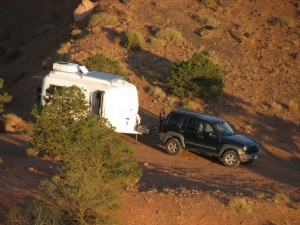
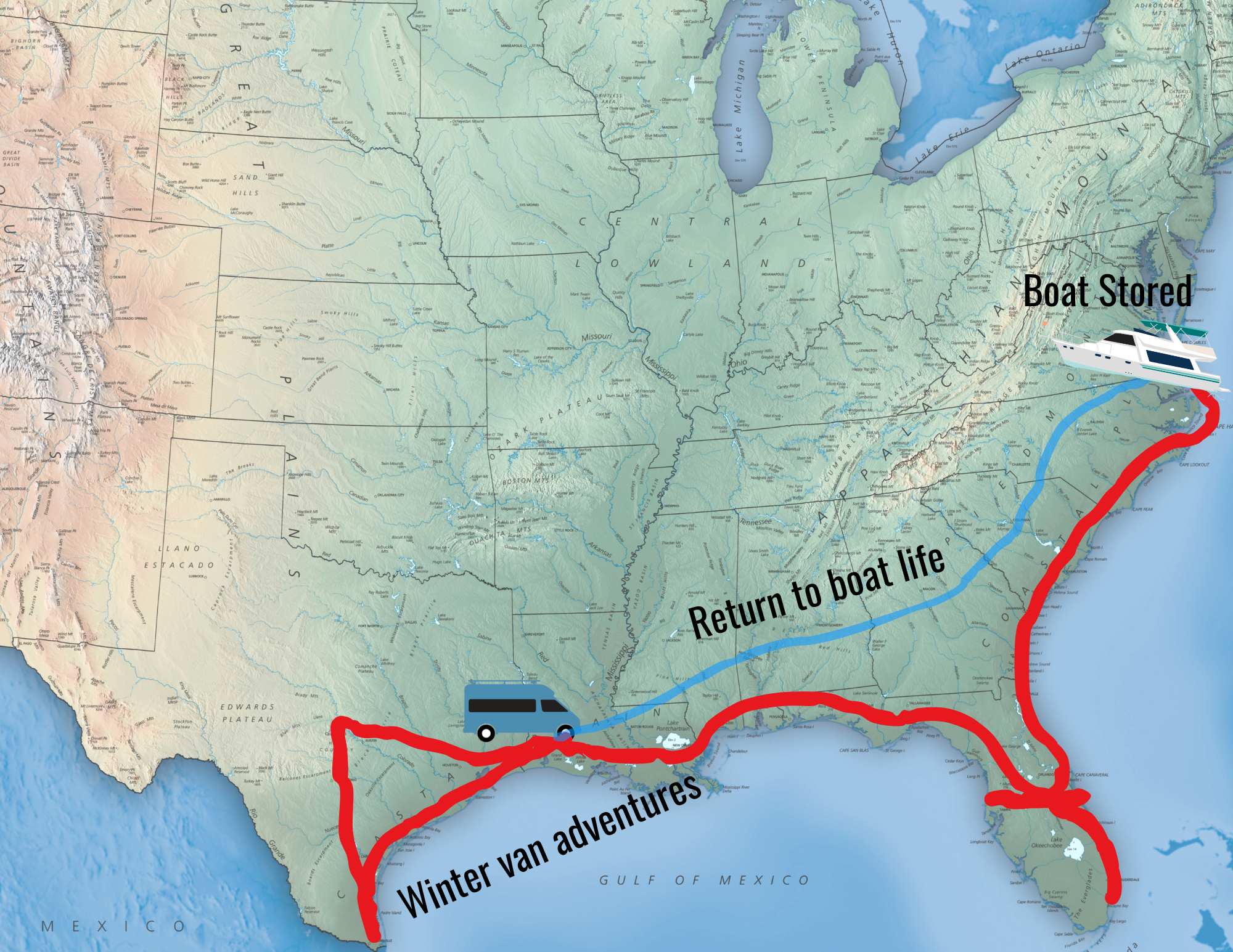
Are you still running the Mac mini of the Carnetix system? I am going full time in July and I want to bring my mini along, but I can’t find a decent way to power it. I have a late 2012 version. I checked the carnetix website, and it seems a bit out of date.
Nope… we ditched that setup years ago when we switched to the bus.
Hi. Thanks for sharing your experience with us.
I’m in the early stage of this RV and power experience, we’re likely to pick up a great near vintage 23 foot RV. We’ve been camping for years and using solar & deep cycle to power equipment and CPAP.
I’d sure like to put a couple of panels on the roof to charge deep cycle batteries, as we’re not likely to be able to plug in where we’re thinking of going.
Then, just to complicate things – is it possible to get a very small generator (like a quiet 1000 watt unit) to give enough of a boost to occasionally be able to run the AC off the grid?
I’m not sure if you can combine battery sourced with generator sourced power like that.
Any thoughts?
Kindly,
Doug
A boosting inverter like ours can combine battery and generator power – but a 1000W generator or even a 2000W generator might struggle with the sudden full load kicking on when used this way.
When we had our Oliver trailer, we were able to just barely run the roof air off a Honda 2000. Solar powered everything else, but if we needed AC off grid we pulled out the small quiet propane-powered Honda.
– Chris
I’ve been a ” tenter” all my life..just bought a 95 coachmen van..very interested in a solar panel for it. I also need to know what is the best compact equipment for a single traveling musician to have (phone, tablet???). ..just learning! Thank you!
Hi Jena… welcome to our blog. We talk a lot about tech on the road, so stick around and search around. If you check out our ‘Start Here’ page (https://www.technomadia.com/start-here), you’ll be linked up with a lot of our relevant content.
This is my first season as a full-timer with no previous experience! I didn’t realize that my Franklin travel trailer is not 4season, but I’m making the best of it. My 40 gal. propane tank only lasts 4 days in the cold weather. At $15 per fill up, this will add up fast! I want to explore solar, but everything about this lifestyle is new, and that’s OK. I came home from work yesterday and some unknown neighbor had changed out my garden hose for a winterized, heat-taped hose! I was so surprised, and very grateful b/c it is 20 degrees F. this morning in NW Georgia! I wonder who this superman is? Anyway, I hope to take my music on the road once I retire from public school teaching in a few years. In the meantime, I have to learn how to tow my 33-footer with a pickup truck. My house sold prematurely, and I didn’t have as much time to study up on this nomadic lifestyle before actually doing it! Still trying to find my gloves and ice scraper!
Hi,
I have kind of similar system in my trailer. I have an R-POD and installed 2 60WATTS flexible solar panels (due to the shape of the trailer) with 2 deep cycle batteries (12V each, not sure on AMP’s) and a 3000WATTS inverter/charger. I have not been able to fully test the system but one night with the inverter on all the time (+/_ 20 Hrs.) only draw about 10% of the batteries charge. One upgrade to do in the future is the MPPT charger controller and the battery monitor. It feels with more pleasant on having this system installed and not worry on the battery’s charge. You will enjoy more your camping time, for sure.
I would not recommend using Wind as an energy source. Wind is generally too variable (gusty) and to really get energy out of wind, the wind needs to be strong (+12 mph, preferably +20 mph), sustained (hour after hour), and there needs to be LOTS of clear area around the turbine and the turbine should be really high to avoid ground turbulence (which reduces wind energy). For the cost of the turbine and tower, you would get far greater benefit from solar panels IME. Not to mention that to also get the best energy out of wind, the blades should be quite long, the alternator robust (heavy magnets) and the tower tall. This is all large heavy cumbersome stuff to haul around and to set up. Small turbines and light or turbulent winds just can’t provide much power and the power isn’t as easy to monitor, which is why wind is often called “Wild Energy”. Physics is physics. Don’t believe the hype or salesmen that say otherwise. Verical windmills also dont provide much energy, so avoid them. Search out Hugh Piggot, or HomePower Magazine for the 411 on wind energy.
IF you camped in an area of strong sustained wind (hour after hour after hour) and or your blades were very large, then it wind would help add power to your system, but other than sailors on the ocean, who camps and enjoys such windy places?
Have either of you discussed the possibility of adding and tying in wind power as an addition to your current setup. I have seen some mobile operations and was wondering if these do really work.
We have looked briefly into it. Our biggest challenge with it is space in a rig as small as ours. It’s not something that could be permanently mounted, and we tend to avoid systems that require setting up and taking down. Thus far, we’ve just not had enough deficiency with our solar setup to merit the cost and hassle.
We are however considering one for a potential future sailboat setup, if we go that route.
Hey Chris & Cherie–
Excellent, informative post. I’m contemplating a solar upgrade soon for my little motorhome and this info will be very useful!
When I was T@Bbing, a few of us used to carry a spare battery in the back of our tow vehicles. I originally used to physically swap this battery out with the trailer battery, but what a PITA that was! Well then a buddy suggested rigging up some cables w/7-way connectors, and that made all the difference!
At night, just plug the trailer’s 7-way cable into this spare battery to get the extra juice needed. In the daytime, run a small cable from your truck to the battery to recharge it as you drive around town (or run a cable from your generator or solar system if you’re staying put).
Here’s a link to what my system looked like:
http://tabventures.blogspot.com/2008/04/battery-recharging-alternative.html
.-= Lynne´s last blog ..Killarney Wildlife =-.
Awesome.. we’ve definitely been contemplating a battery bank in the tow vehicle to do exactly that.
In our T@b days, we actually converted the battery compartment to hold two batteries (260 amp hours), a 1000w inverter and solar charger all off a single 110w panel. Worked pretty well.
Ya know what works VERY WELL for getting power that distance? Welding wire.
My brother works at Airgas. They have spools of large, oxygen-free wire that works very well for taking 12v the distance of a vehicle and not losing much power.
I used it from the battery bay, to the main cut-off, to each of the fuse blocks (4). This way I can deliver large current if needed, or just higher-voltage to each location.
Since the design of the trailer has been worked out along the way, having the 12v power worked out this way helped with the flexibility. (And I can weld in the shower.)
:>
.-= Brian Fahrlander´s last blog ..Second Power Supply Test Underway =-.
Have you ever added up your overall energy usage, and determined the fraction of energy you use from solar, LP, gasoline and grid?
Sounds like you get about one kilowatt-hour per day from solar (100wattx2x5hr) at best. That’s about 10 cents worth per day, or $3 per month. So the solar offsets about one gallon of gasoline per month, from a cost perspective, and probably from an energy use perspective as well.
No, we’ve never run those figures.. as our motivation for solar wasn’t cost savings, but rather increased options. And our energy sources are so variable on climate, still vs moving and what we’re doing.. that’s it’d be quite difficult to get numbers that really mean anything.
However, the house itself has nothing that is gasoline run directly (charging while towing is a side effect of transitioning locations), so that’s really not much of a relevant comparison. We also hardly ever pay separately for grid power, as it’s generally included in campground fees. Considering we can run entirely off solar & propane for weeks on end (and optimized for that)… our solar consumption can make up a significant portion of our home energy use.
Please consider using my new math. If one needs to generate 1,000 watts electric on the road, assuming your generator is already paid for & needs ZERO maintenance and you have a Honda 2000 – It costs no less then $1.00 in gas to generate 1,000 watts. Not sure where you get 10 cents per KW….but i’m willing to move there ASAP !!
Cheers Jerry
Just wanted to pop in and say hello. Pace from Freak Revolution recommended I check you out.
I’m a full timer in a 1966 Airstream Safari, along with my Best Beloved and two cats. The open desert of Quartzsite AZ was the spot that convinced us to get serious about our solar install. We want to spend more time boondocking and solar makes so many more options feasible. Our 1966 Airstream Overlander will be the recipient of said solar install. We hope to have it on the road after a full restoration by this autumn.
Thanks very much for your informative site and hopefully we’ll see each other on the road sometime.
Cheers!
Twitter: Poesleeve
.-= Charon´s last blog ..Gearing Up For Spring =-.
Thanks for stopping by Charon.. awesome to encounter other of us freak RVers 🙂 You should also check out http://www.nurvers.com – it’s our community of younger full time RVers. We’re actually having a rally next week.
The options that solar gives you are awesome. We’ve not done QZ yet.. but hope to get there some day… but Slab City will likely call us stronger for its quirky freak nature. 🙂
Thanks for the heads up! We’ll check out the site and see what’s happening this year amid our travel and show schedules. We love meeting new people along the road.
Have a blast at Slab City when you get there. If you’re crafty, bring your artwork to help support the barter economy there.
Cheers!
.-= Charon´s last blog ..Gearing Up For Spring =-.
Oh I agree Brian. It’s not the timeframe that worries me. I should have plenty of time to do the install prior to August. It’s the issue of whether the difficulty of the install itself exceeds my abilities. And my abilities are, admittedly, somewhat limited.
My personal feeling on issues like this is to do _the_best_job. If you hurry something to get it in by a certain date, you’ll have a part of your vehicle that’s never-quite-good-enough; marred by the schedule.
Better to have a properly-installed, completely-working device than a botched job with a memory that fades. :/
.-= Brian Fahrlander´s last blog ..Second Power Supply Test Underway =-.
Awesome stuff, thanks for sharing! We’re debating on how to approach our solar system right now. Part of me wants to tackle the install myself to have it in by Burning Man, but I’m contemplating having someone do it. Logistically, though, it won’t be until late September when we’ll be in the area of the people who would be installing it. Did you find the install required any special skills or was it something the average joe could do with some time and patience?
Japhy – Chris will likely answer as well when he has a chance (he’s currently deep in taxes).
However, I can comment on some of skills and resources needed:
– Space to do it. One problem we ran into this last round was not having a workshop to do the work at, and my neighborhood in Florida being most anti-RV – so couldn’t even do the work in the driveway. With the Tab, Chris was blessed to have been able to use Steve Robert’s Nomadic Research Labs as an indoor workshop to complete the project.
– Comfort working with electricity, and knowledge thereof. It’s easy to do things wrong if you don’t know what you’re doing. Chris has a fairly high degree of comfort and knowledge of things electrical… and we’ve both gone to several solar workshops.
– Comfort drilling things through your rig. Your solar panel mounting will need to be darn secure (would be pretty awful to have panels flying off down the highway).
– Perhaps a bit of carpentry comfort – depending on what wiring and battery/charger compartment modifications you might need to make, as well as installing the monitoring panel.
I think it all comes down to – how confident are you in your self to research and trust that you can learn as you go? How comfortable are you cutting into your house? Do you have nearby friends who might be able to help? Sounds like you have time on your side so it wouldn’t be a rush job – so if sounds like something you want to tackle, there’s a great deal of pride that comes with having done it yourself.
Yeah, I’m part of the demographic you describe; I’ve wondered if solar could make a difference. Most of it’s a strategic decision.
I don’t plan to ever “boondock”. The trailer’s just too small, not to mention the budget, to get completely self-contained. But then, I’m expecting to ‘orbit’ a city or town, since that where the jobs and people are. As much as I love Jackson Hole, WY, there’s just nothing out there on the mountain that I love to see.
Instead, I take a 12V mostly attitude; everything I do is built for 12V where possible. The few exceptions are for flat panels and/or monitors just now; all that I have are still 110v based, but not forever. Doing so makes me more flexible.
I’ve made good progress with converting computers to 12v vehicle feed; a replacement power supply is required. And machines I’m running on 110 now will be 12 when my Mom no longer needs me.
What sort of shower accommodations do you have in there? Our vehicles seem of similar size…
.-= Brian Fahrlander´s last blog ..Second Power Supply Test Underway =-.
The Oliver has a small wet bath.. pictures can be found on our RV tour page:
https://www.technomadia.com/oliver/
It’s quite functional 🙂